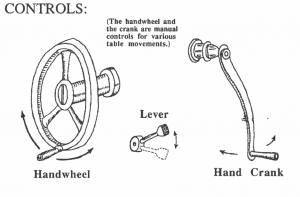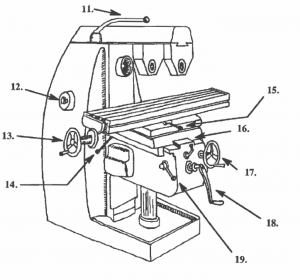Lesson 2B Horizontal Milling Machine Controls

Spelling
HORIZONTAL MlLLING MACHINE CONTROLS
The horizontal mill has several important controls:
1. ON/OFF switch (letter L, as seen in the picture): The most important control on the mill is the ON/OFF switch, located above the machine and equipped with a large, easy-to-reach handle; this makes it possible for the machinist to quickly and easily tum off the mill, in case of an emergency.
2. Speed-change dial (M): This control allows the machinist to set the speed at which the spindle turns. This is measured in a certain number of RPMs. The machinist must check to see if the speed change can be made when the mill is operating, or if it should first be stopped.
3. Knee clamp (0): This control allows the machinist to lock the knee, so that it will not move up or down.
4. Table-movement controls: Each movement of the table is controlled by two sets of controls–one is automatic, the other is manual.
a. Vertical feed controls: These allow the machinist to control the up and down movements of the knee; there are both automatic and manual controls.
1) Vertical feed engaging lever (T): This is the auto matic control.
2) Vertical feed hand crank (S): This manual control has a shaft and a handle which are turned to raise and lower the knee.
b. Table feed controls: For longitudinal movement of the table.
1) Table feed engaging lever (P): This lever, when engaged, allows for automatic feed at a certain rate.
2) Table feed handwheel (N): This handwheel allows the machinist to control longitudinal feed by hand; he/she can go as fast or as slow as needed, or stop at any time.
c. Cross feed controls: These controls direct the movement in, toward the column, or out, away from it.
1) Cross feed engaging •ever (Q): Automatic control of the cross feed.
2) Cross feed handwheel (R): Manual control of the cross feed.
This may seem like many controls to learn, but you will learn them well when you start practicing on a real machine. You will get a “feel” for the machine and its controls that will allow you to make parts easily and well. It’s like learning to dance, except with the mill you must always stay alert, for safety reasons. If your mind wanders, you can lose a finger, a hand, or an arm. When dancing, all you have to lose is your heart.

Exercise 16: Chart task?
Questions
Exercise 18: Image and task?
Controls Identification (matching)

Controls Identification (cloze spelling)

Controls Identification

Situation: Two machine shop students, Pran and Victor, are looking at the controls on a horizontal milling machine on their first day in class.
Pran: Look at this, Victor. Here’s all the controls that we learned in the VESL class.
Victor: Yes, you’re right. Let’s see if we can find and name them all.
Pran: Okay. Let’s start with this big handwheel on the left at the end of the table. That must be the table feed handwheel.
Victor: You’re right. That’s the one for longitudinal feed.
Pran: That’s a manual feed, and the automatic one is here near the middle of the table–it’s called the table feed engaging lever.
Victor: Yes, and here’s another pair: the cross feed engaging lever and the cross feed handwheel.
Pran: Right, they’re the ones that move the saddle in and out.
Victor: Man, we remember a lot of things from VESL. I really want to start using the machine!
Conversation No. 2:
Victor: Oh, here’s that crank. Do you remember what it was for?
Pran: I do! It was to raise or lower the knee–it was called the vertical feed hand crank.
Victor: And–let’s see–on the left side of the knee is the vertical feed engaging lever–for automatic use.
Pran: What else do we have? There’s the on-off switch, and here’s the speed change dial. Oh–and there’s the knee clamp.

